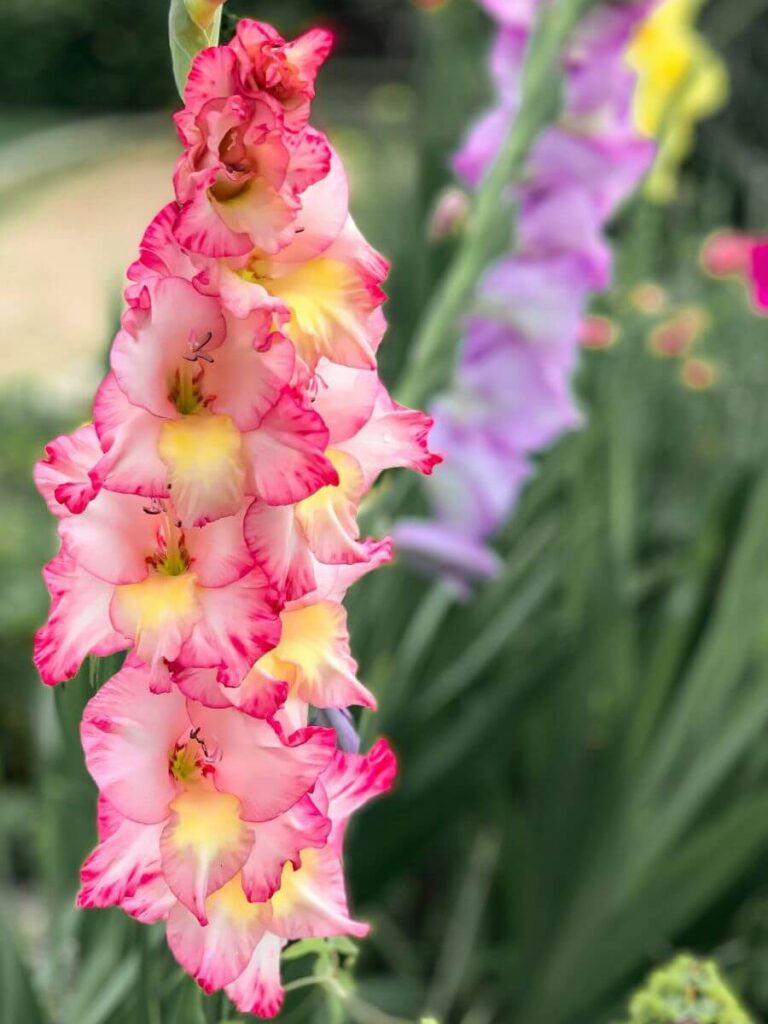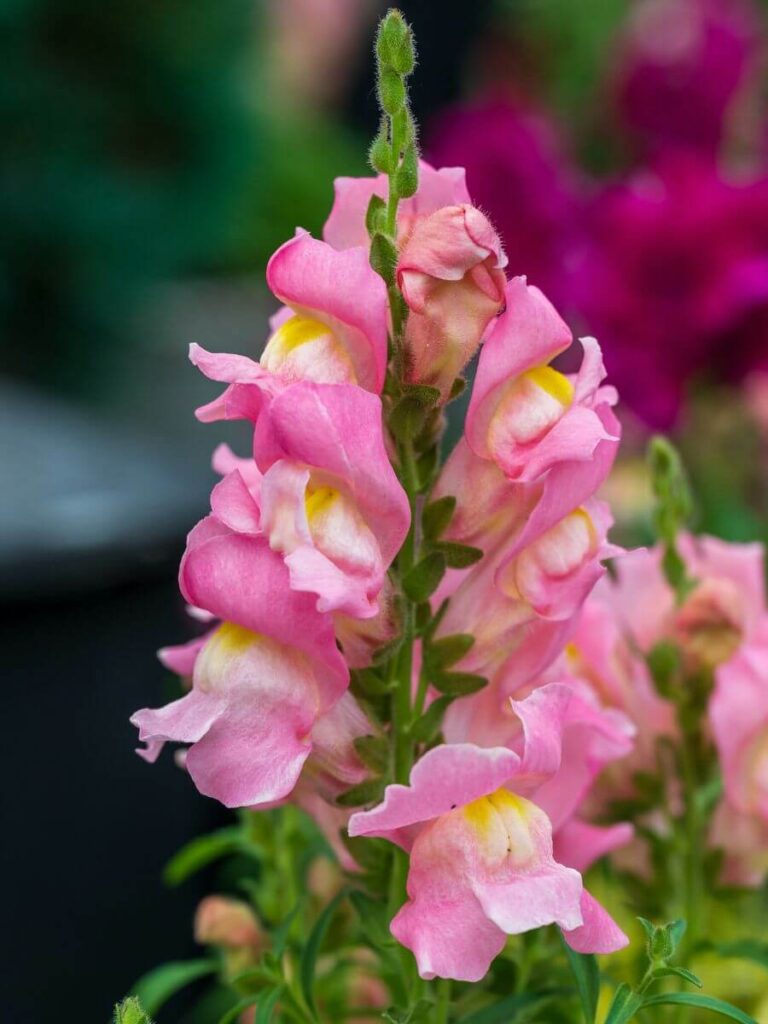Hey there,
Gladiolus is a wonderfully attractive and dignified flower – one of my favorite – which everyone loves, it thrives beautifully in gardens whether planted individually or in groups, but also holds its own when arranged in bouquets as a cut flower.
The Gladiolus is a genus belonging to the family of Iridaceae, which genus includes about two hundred and fifty species, ten of which live in Europe and Asia, and the rest in Black Africa. Its largest distribution area is the Republic of South Africa and Namibia. The number of hybrid species is estimated to be in the thousands. It came to Europe in the second half of the eighteenth century, where new species were bred.
You can find many kinds of bred versions in gardens and parks: there are hybrids with ruffled petals and full flowers. In general, wild species are smaller and more modest than their garden counterparts.
Description of Gladiolus
The gladiolus is an annual ornamental plant.
There are many varieties of the plant, they can be shorter or taller. Dwarf gladiolus can be planted in smaller gardens, which are only fifty to sixty centimeters high.
A profusely flowering large plant, which is eighty to one hundred and fifty centimeters high, requires staking, otherwise, it cannot support itself, and it will collapse. Its stem does not branch, it grows long furrowed leaves. The flowers, located on sturdy stems, form funnel shapes, arranged in clusters and open from bottom to top.
The gladiolus blooms from spring to autumn, so the old ones wither when the new flower petals open. It has many shades besides blue and black.
The flowers stand upright and take on a sword-like shape.
The plant is not frost-hardy, so the bulbs must be picked up before the frosts and overwintered in a cool place. The color of the onion tubers is brown and they are wrapped in fibrous membranes.
Planting the Gladiolus
The Gladiolus bulbs can be planted continuously from mid-April to late May. When planting in the garden, place the bulbs 10-15 centimeters deep in the soil, spacing them 15-20 centimeters apart. If the spring is rainy enough, then there is no need to water them, but if natural rainfall is not adequate, the plants should be watered.
During the summer, you can help stimulate flowering by occasionally adding fertilizer to the watering. There are various ways to plant the bulbs, and by grouping colors, you can create different shapes and color combinations. Be creative in spring, and you’ll enjoy a beautiful view in summer!
You can extend the flowering period by planting Gladiolus in multiple stages rather than all at once. Gladiolus typically begins flowering around 90 days after planting.
The planting soil should be rich in nutrients and have good drainage. The plant prefers a sunny location, so plant them in a sunny area of your garden.
Propagation of Gladiolus
Gladiolus may produce offsets, which are small side bulbs that develop around the base of the parent bulb. During autumn digging, it’s advisable to select the offset bulbs so that we can plant them in another bed in the spring.
However, it’s important to know that offset bulbs only bloom 2-3 years later, and often only in moderate quantities. For them to develop and grow optimally, it is essential to plant them outdoors. This provides them with the right environment and growth opportunities.
Diseases and pests of Gladiolus
It is resistant to diseases and there is no need to fear the appearance of pests. Sometimes thrips, aphids, snails, gray mold, and various leaf, stem, and tuber rots can occur, against which local protection is recommended.
We can prevent the appearance of diseases and pests by only keeping healthy, firm bulbs. Another defense method is by rotating the planting location each year, not planting the same plant in the same place annually. If the plant turns yellow, it often indicates a viral infection. Destroy the infected plants immediately, as they can infect other bulbs.
Growing Gladiolus in pots
Gladiolus bulbs can also be planted in pots. Especially the lower varieties are ideal for this. Pay attention to the planting depth, otherwise the flowers will fall. It is worth choosing a longer, elongated pot.
The soil in the pot dries out sooner, so it requires regular watering in the summer.
During winter, the bulbs planted in pots can remain in the pots, but place them in a frost-free, sheltered location, such as a room with temperatures around 8-10°C.
In spring, only move them back outdoors once the frost has passed.
Picking up and overwintering of the Gladiolus
After flowering, allow the plant to dry out naturally, without cutting back the flower stems, as they store nutrients in the bulbs. Since the bulbs cannot tolerate frost, they should be picked up in autumn. Remove the bulbs from the soil at the end of September or early October, trim the remaining stems to about 5 cm, clean them, and let them dry out.
Leave them in a dry, well-ventilated place for a few weeks until the leaves and stems dry out completely. During winter, store the bulbs in a frost-free, dry area with temperatures around 8-10°C. It’s a good idea to place newspapers between the bulbs to absorb any moisture.
Bulbs planted in pots can remain in the pots, but move them to a protected area, like a room with temperatures around 8-10°C. They do not need watering during the winter dormancy period.
Interesting facts about Gladiolus
The Gladiolus carries various meanings in the language of flowers. These include character, strength, remembrance, arrogance, magnificent beauty, leave me alone, I’m truly honest, flowers of gladiators, admiration, piercing the heart like a sword. Its name originates from the Latin word “gladius,” meaning sword. It is also the flower of the month for August and can symbolize taking a break, as well as strength, grandeur, and beauty.
In the past, it was believed that a son would be born to the woman who wore it on her belt. The phallic-shaped plant, the flower of the male principle, is said to help the birth of a boy in marriage when tied into a wedding bouquet and will improve a man’s performance in bed.
Conclusion
The Gladiolus is a remarkable flower known for its striking beauty, resilience, and diverse symbolism. From its characteristic sword-shaped leaves to its vibrant blossoms, the Gladiolus captivates gardeners and enthusiasts alike. Understanding its growth cycle, planting requirements, care, and winter maintenance is essential for cultivating these stunning flowers successfully. Whether planted in gardens or pots, Gladiolus adds a touch of elegance and meaning to any landscape, making it a beloved choice for floral arrangements, symbolic gestures, and personal enjoyment.







0 Comments